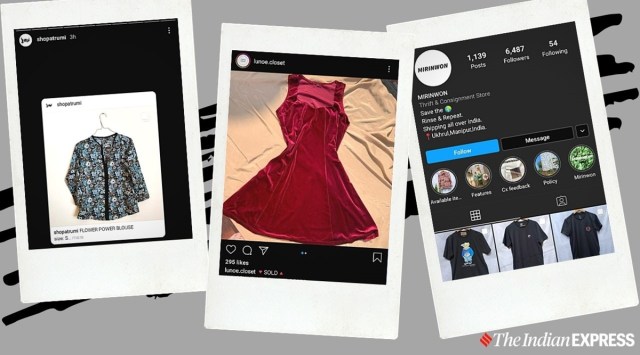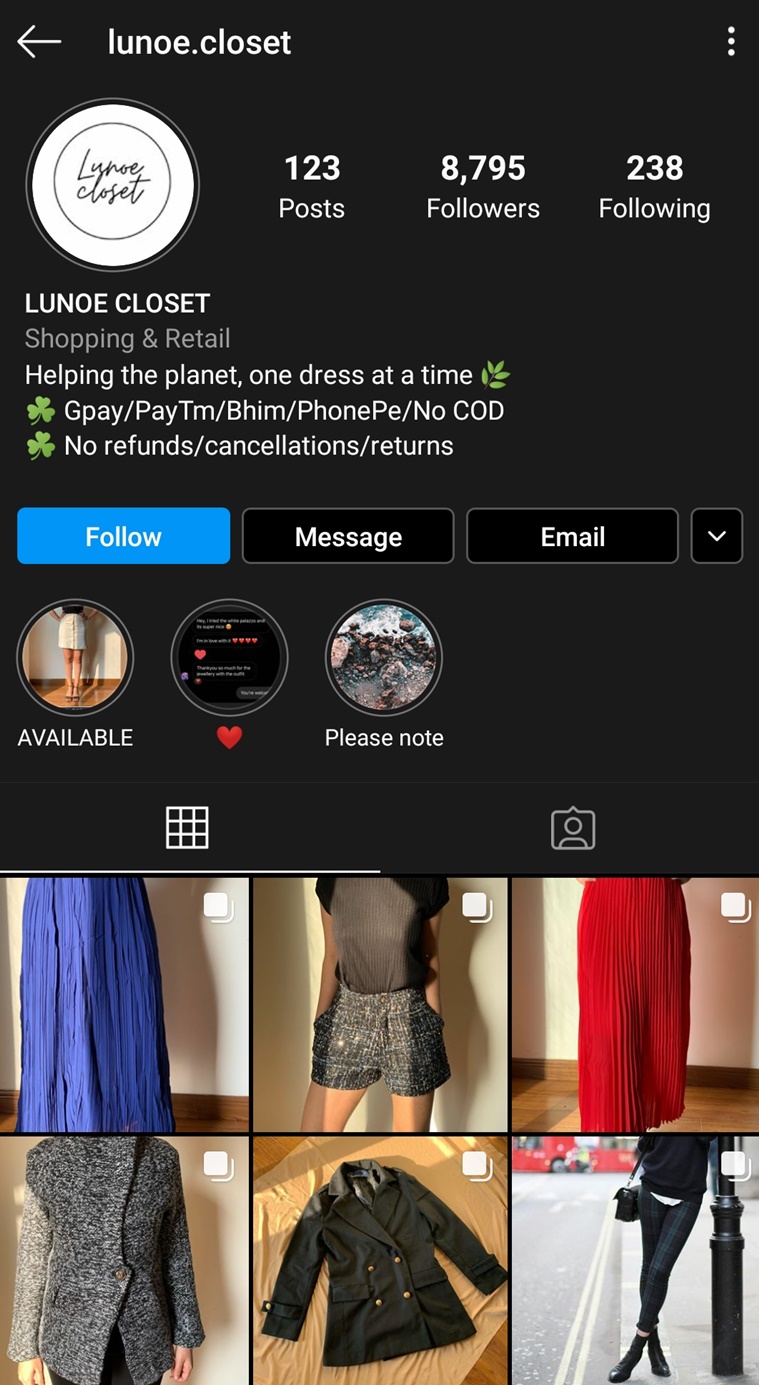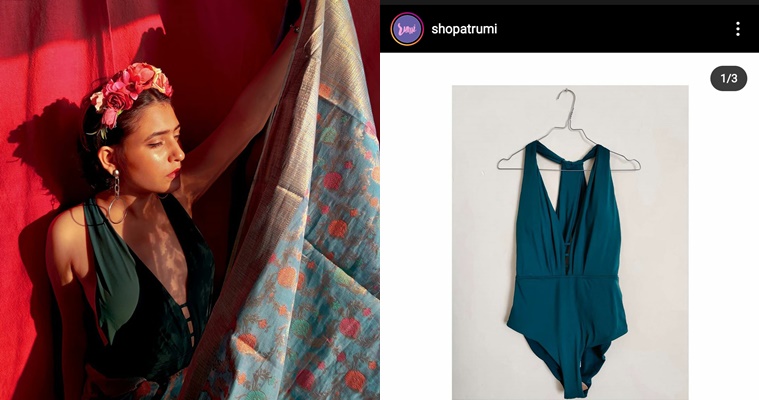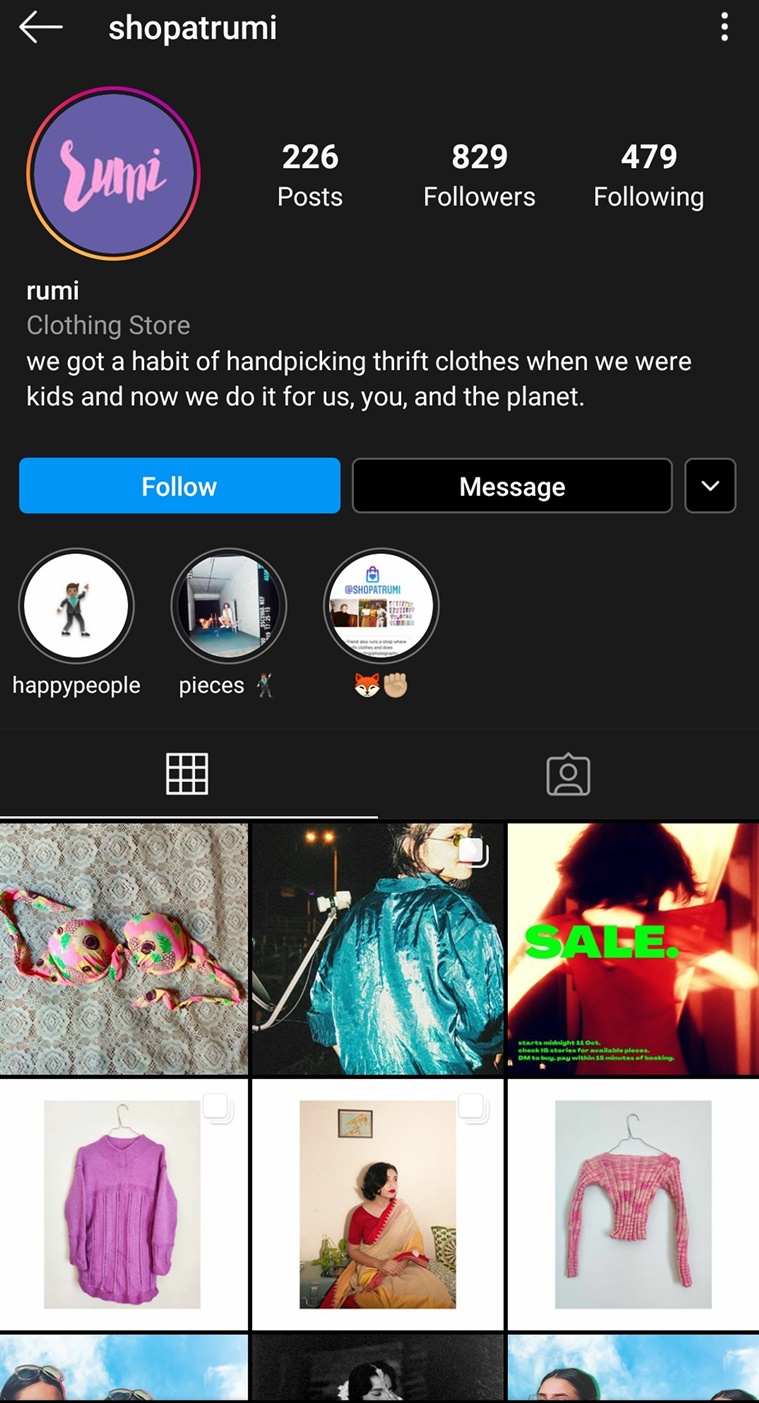- India
- International
There’s a world of thrifting and slow fashion thriving online; check it out
Thanks to Instagram, thrift stores are more accessible than ever now. Every week, the stores announce a “drop”, which includes a set of carefully-curated second-hand clothing pieces for sale on a particular given day and time
 If you have been thinking of jumping into the bandwagon of slow fashion, this is your chance to do it sans hassle. (Photo: Lunoe closet, Shopatrumi, Mirinwon/ Instagram, Designed by Shambhavi Dutta)
If you have been thinking of jumping into the bandwagon of slow fashion, this is your chance to do it sans hassle. (Photo: Lunoe closet, Shopatrumi, Mirinwon/ Instagram, Designed by Shambhavi Dutta)For 20-year-old Mansavi* (name changed), a Delhi University student, shopping sprees at Sarojini Nagar and Janpath to update her wardrobe was almost a monthly affair. While the pandemic put a stop to physical shopping, she soon found a way out. After much browsing, researching and review-reading, she has turned to thrift stores on Instagram — which sell second-hand clothes at nominal prices — which are thriving ever since the world got restricted to their houses.
ThredUP, an online thrift store, did a survey of 3,500 women earlier this year and found out that at least 70 per cent of women are open to buying second-hand clothes. Not only that, but the report also mentioned, “online secondhand is set to grow 27 per cent in 2020, while the broader retail sector is projected to shrink 23 per cent”.
READ| Without sustainability, fashion will become irrelevant: Designer Anita Dongre
Handled with love
Among the many such initiatives is Lunoe Closet, a Delhi-based online thrift store that started in June 2020 with the motto “helping the planet, one dress at a time”. Ishita Sharma (31), who handles the store along with her friend, says they started by raiding their own wardrobes first and then moving on to their friends’. Soon, they became known and were approached by small boutiques, manufacturing units that were hit by COVID-19. “They were willing to part with their leftover stocks. We have partnered with eight vendors across India, who sell their stocks via our page. The clothes, which may have ended up in a landfill, now end up with someone who cherishes them,” said Sharma.
View this post on Instagram
For Pranjal Asha (23), who runs Rumi, a Mumbai-based thrift store that went live in 2018, the sources for thrifting are varied. “I thrift straight from factories or places which aren’t well-known to people. This is where they mostly have kept the rejects aside and sell them at extremely cheap prices like Rs 80-100 per piece. But they are only interested if we buy a lot of it i.e at least 100 pieces at a time.”
 Lunoe’s Closet started this year in June. (Photo: lunoe.closet/ Instagram)
Lunoe’s Closet started this year in June. (Photo: lunoe.closet/ Instagram)
The stores not only thrive on the idea of selling clothes at nominal prices but also tap on the concept which is extremely popular in the West. “In the West, thrifting has been mainstream for long; picking up pre-loved and vintage items from garage sales or flea markets is a fairly common practice,” said Sharma. When Lunoe launched its first collection on the ‘gram it was sold out within a day. “It was heartening to see that people had embraced thrifting to such an extent, which naturally encouraged us to move forward with more drops,” said the co-owner of Lunoe Closet.

 Posting aesthetic photographs of the items helps a lot in selling, says Pranjal Asha. (Photo: shopatrumi/ Instagram)
Posting aesthetic photographs of the items helps a lot in selling, says Pranjal Asha. (Photo: shopatrumi/ Instagram)
Asha said she receives at least 15-20 orders every day. However, she believes that it is not just nominally priced clothes that entice customers but also how “creative and well-aware” a thrift store is. “I am a photographer, thus it has never been a problem for me to put up aesthetic photographs of the items — this helps a lot in selling. Also, as a thrift brand, one needs to have enough knowledge about the texture and fabric of the pieces. The more aware you are of what you’re selling, the more you sell,” she told indianexpress.com
ALSO READ | From creating awareness to wearable fabric: How companies are fighting single-use plastic pollution
Process of selecting the outfits
Words like ‘thrift’ and ‘second-hand’ often bring an assumingly vivid picture of torn, faded and dirty clothes. But virtual thrift stores have changed that outlook.
“It all begins with thinking like a customer. We have to ensure the product is in good condition. If there are minor damages like missing buttons or broken zippers, we get them fixed before putting it out for sale,” told Sharma. But, she pointed out that the retail value of each piece is determined by its condition. “While a pair of denim from Zara may retail for somewhere around Rs 800-1,100 depending on the condition, a pair of well-kept vintage Levi’s denim can easily be retailed for around Rs 1,700-2,000.”
She said they also ensure the hygiene of all clothes. “All pre-loved items are dry cleaned. Our vendors also carry out sanitisation of products before they are dispatched from our facility in Delhi.”
Agreeing, Ngahon Tungshangnao (27), who runs the Manipur-based thrift store, Mirinwon, said the process of ensuring hygiene is a task in itself due to few dry-cleaning centres in Manipur. “I handwash all the items. I rinse them and then dip in a fabric conditioner for a few minutes, as the last stage of cleaning. For bags and shoes that are not washable, I make sure to disinfect and sanitise them with a quality disinfectant,” she said.
 Rumi has been running for the past two years, it receives 15-20 orders on an average day. (Photo: shopatrumi/Instagram)
Rumi has been running for the past two years, it receives 15-20 orders on an average day. (Photo: shopatrumi/Instagram)
Buying thrift items
Thanks to Instagram, thrift stores are more accessible than ever now. Each store announces a “drop”, which is basically a set of carefully curated clothing pieces meant to sell on a particular given day and time, once or twice a week. Few days prior to the release, they offer ‘sneak peeks’ on their Instagram stories for the consumers.
 Notification for the upcoming sale at Rumi, an online thrift store. (Photo: shopatrumi/Instagram)
Notification for the upcoming sale at Rumi, an online thrift store. (Photo: shopatrumi/Instagram)
Zeite Chongsothem (21), a civil services aspirant, who has been thrifting for “as long as she can remember”, said that before the pandemic came into force she would regularly visit thrift stores — a habit which has now gone online. The reason she thrifts is because “other than being environmentally sustainable and supporting homegrown businesses, the price is reasonable.”
“The one good thing about thrifting is that most of the times, the quality of the clothes is not compromised. But even if there is slight wear and tear, it’s nothing that cannot be fixed,” she said. However, she offers a suggestion for those looking to buy their first pre-loved outfit: “Don’t get anything very expensive. Always start with something cheap so you aren’t left feeling dejected if it doesn’t turn out how you had expected it to be.” Also, she added, “make sure you go for stores which are inclusive of the sizes and never hesitate in asking them for more details because most of these stores don’t take refunds or returns.”
All — Lunoe, Mirinwon and Rumi — share that most of their customer base comprises of college-going girls or working women across India, and sometimes from countries like New York and Sweden.
For consumers like Shaiza Suhail (23) thrifting is a conscious decision which she made in 2019 to be more environmentally friendly. “I made that switch simply because I began hoarding clothes from fast fashion brands which were just trendy and not good quality,” the teacher said. This is exactly what thrift shops advocate — the need for mindfulness — cutting out the excess and understanding that you indulge in fashion once in a while.
Asha, who has been practising thrifting since her childhood, shares a bittersweet story of how her mother wore a Rs 80 sari when she met late former CM Sheila Dikshit. “Once you’re used to thrifting, you stop caring about the money factor. Thrifting is pocket-friendly, and it almost works like a chain. The thought of you spending money on your little black dress and getting half that price back when you’re bored or don’t fit in it anymore is very calming!” she adds.
For more lifestyle news, follow us: Twitter: lifestyle_ie | Facebook: IE Lifestyle | Instagram: ie_lifestyle
More Lifestyle
Buzzing Now
Apr 18: Latest News
- 01
- 02
- 03
- 04
- 05


































